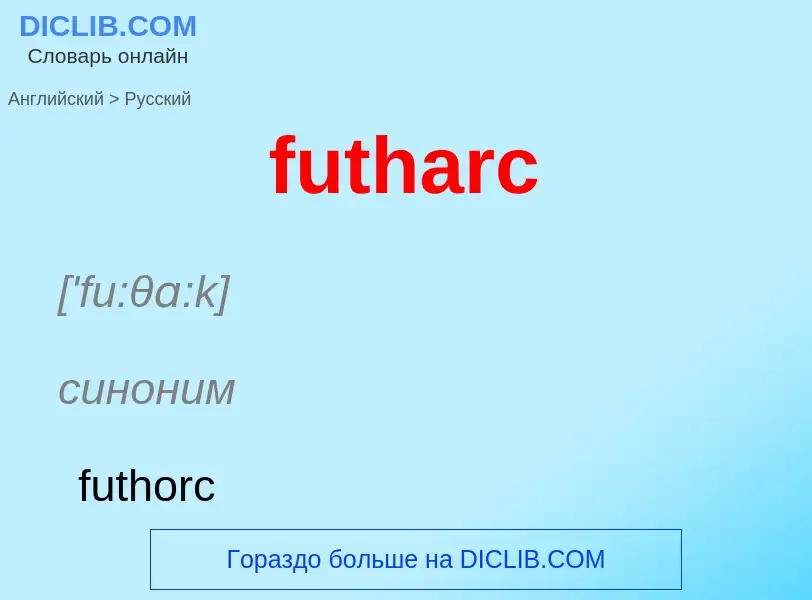Translation and analysis of words by ChatGPT artificial intelligence
On this page you can get a detailed analysis of a word or phrase, produced by the best artificial intelligence technology to date:
- how the word is used
- frequency of use
- it is used more often in oral or written speech
- word translation options
- usage examples (several phrases with translation)
- etymology
futharc - translation to russian
['fu:θɑ:k]
синоним
['ru:nik]
прилагательное
общая лексика
таинственный
магический
лингвистика
рунический
редкое выражение
древнескандинавский (о поэзии)
существительное
['ru:nik]
общая лексика
руническая надпись
лингвистика
руническое письмо
Definition
Wikipedia

A rune is a letter in a set of related alphabets known as runic alphabets native to the Germanic peoples. Runes were used to write various Germanic languages (with some exceptions) before they adopted the Latin alphabet, and for specialised purposes thereafter. In addition to representing a sound value (a phoneme), runes can be used to represent the concepts after which they are named (ideographs). Scholars refer to instances of the latter as Begriffsrunen ('concept runes'). The Scandinavian variants are also known as futhark or fuþark (derived from their first six letters of the script: F, U, Þ, A, R, and K); the Anglo-Saxon variant is futhorc or fuþorc (due to sound-changes undergone in Old English by the names of those six letters).
Runology is the academic study of the runic alphabets, runic inscriptions, runestones, and their history. Runology forms a specialised branch of Germanic philology.
The earliest secure runic inscriptions date from around A.D. 150, with a potentially earlier inscription dating to A.D. 50 and Roman senator Tacitus's potential description of rune use from around A.D. 98. The Svingerud Runestone dates from between A.D. 1 to 250. Runes were generally replaced by the Latin alphabet as the cultures that had used runes underwent Christianisation, by approximately A.D. 700 in central Europe and 1100 in northern Europe. However, the use of runes persisted for specialized purposes beyond this period. Up until the early 20th century, runes were still used in rural Sweden for decorative purposes in Dalarna and on runic calendars.
The three best-known runic alphabets are the Elder Futhark (ca. A.D. 150–800), the Anglo-Saxon Futhorc (400–1100), and the Younger Futhark (800–1100). The Younger Futhark is divided further into the long-branch runes (also called Danish, although they were also used in Norway, Sweden, and Frisia); short-branch or Rök runes (also called Swedish-Norwegian, although they were also used in Denmark); and the stavlösa or Hälsinge runes (staveless runes). The Younger Futhark developed further into the medieval runes (1100–1500), and the Dalecarlian runes (c. 1500–1800).
The exact development of the early runic alphabet remains unclear but the script ultimately stems from the Phoenician alphabet. Early runes may have developed from the Raetic, Venetic, Etruscan, or Old Latin as candidates. At the time, all of these scripts had the same angular letter shapes suited for epigraphy, which would become characteristic of the runes and related scripts in the region.
The process of transmission of the script is unknown. The oldest clear inscriptions are found in Denmark and northern Germany. A "West Germanic hypothesis" suggests transmission via Elbe Germanic groups, while a "Gothic hypothesis" presumes transmission via East Germanic expansion. Runes continue to be used in a wide variety of ways in modern popular culture.


![Closeup of the runic inscription found on the 6th- or 7th-century [[Björketorp Runestone]] located in [[Blekinge]], Sweden Closeup of the runic inscription found on the 6th- or 7th-century [[Björketorp Runestone]] located in [[Blekinge]], Sweden](https://commons.wikimedia.org/wiki/Special:FilePath/Björketorpsstenen runor.jpg?width=200)
![Alu]]'' Alu]]''](https://commons.wikimedia.org/wiki/Special:FilePath/Bracteate from Funen, Denmark (DR BR42).jpg?width=200)
![Runic script on an 1886 gravestone in [[Parkend]], [[England]] Runic script on an 1886 gravestone in [[Parkend]], [[England]]](https://commons.wikimedia.org/wiki/Special:FilePath/EBay 025.jpg?width=200)
![An illustration of the [[Gummarp Runestone]] (500–700 AD) from [[Blekinge]], Sweden An illustration of the [[Gummarp Runestone]] (500–700 AD) from [[Blekinge]], Sweden](https://commons.wikimedia.org/wiki/Special:FilePath/Gummarpstenen.gif?width=200)
![Detail of the Elder Futhark inscription on a replica of one of the 5th-century AD [[Golden Horns of Gallehus]] found on [[Jutland]], now Denmark Detail of the Elder Futhark inscription on a replica of one of the 5th-century AD [[Golden Horns of Gallehus]] found on [[Jutland]], now Denmark](https://commons.wikimedia.org/wiki/Special:FilePath/Inscription on Golden horn of Gallehus.jpg?width=200)


